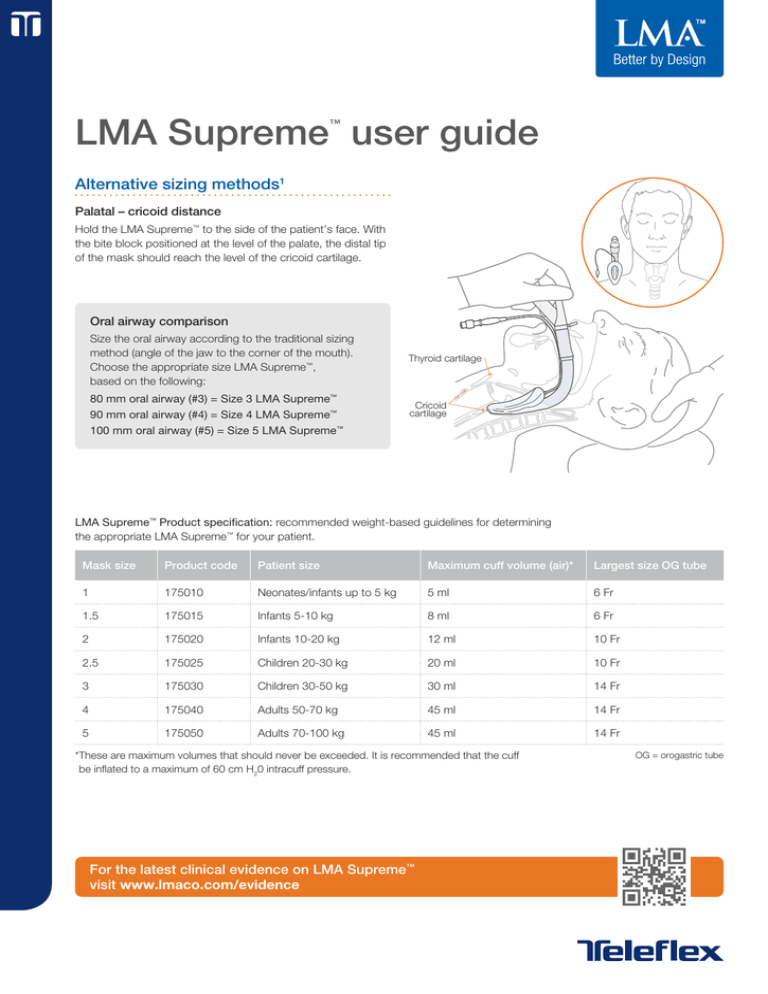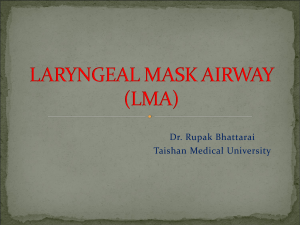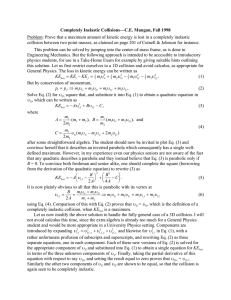
LMA Supreme user guide
™
Alternative sizing methods1
Palatal – cricoid distance
Hold the LMA Supreme™ to the side of the patient’s face. With
the bite block positioned at the level of the palate, the distal tip
of the mask should reach the level of the cricoid cartilage.
Oral airway comparison
Size the oral airway according to the traditional sizing
method (angle of the jaw to the corner of the mouth).
Choose the appropriate size LMA Supreme™,
based on the following:
80 mm oral airway (#3) = Size 3 LMA Supreme™
90 mm oral airway (#4) = Size 4 LMA Supreme™
100 mm oral airway (#5) = Size 5 LMA Supreme™
Thyroid cartilage
Cricoid
cartilage
LMA Supreme™ Product specification: recommended weight-based guidelines for determining
the appropriate LMA Supreme™ for your patient.
Mask size
Product code
Patient size
Maximum cuff volume (air)*
Largest size OG tube
1
175010
Neonates/infants up to 5 kg
5 ml
6 Fr
1.5
175015
Infants 5-10 kg
8 ml
6 Fr
2
175020
Infants 10-20 kg
12 ml
10 Fr
2.5
175025
Children 20-30 kg
20 ml
10 Fr
3
175030
Children 30-50 kg
30 ml
14 Fr
4
175040
Adults 50-70 kg
45 ml
14 Fr
5
175050
Adults 70-100 kg
45 ml
14 Fr
*These are maximum volumes that should never be exceeded. It is recommended that the cuff
be inflated to a maximum of 60 cm H20 intracuff pressure.
For the latest clinical evidence on LMA Supreme™
visit www.lmaco.com/evidence
OG = orogastric tube
LMA Supreme™ user guide
LMA Supreme™ insertion technique
1
Fully deflate the mask for insertion. Attach a syringe.
Compress the distal tip of the mask with thumb and index
finger. Apply slight tension to the inflation line while removing
all air until a vacuum is felt. Disconnect the syringe.
3
Place the patient’s head in a neutral or slight “sniffing”
position. Hold the LMA Supreme™ at the proximal end with
the connector pointing downward to the chest and the tip of
the distal end pointing toward the palate.
5
Continue until resistance is felt. The distal end of the mask
should now be in contact with the upper esophageal
sphincter. The device is now fully inserted.
*Alternatively, taping can be done after the esophageal seal is confirmed. Inward pressure
should be applied throughout inflation and ventilation, prior to taping in place.
2
Generously lubricate the posterior surface of the cuff and
airway tube.
4
Press the tip of the mask against the hard palate. Maintaining
pressure against the palate, continue to rotate the mask
inwards in a circular motion following the curvature of the hard
and soft palate.
6
Maintaining inward pressure, secure the mask into position by
taping cheek to cheek across the fixation tab. This should be
done prior to inflation. Inflate with the minimum amount of air
needed to achieve an effective seal. The recommended
intracuff pressure should not exceed 60 cm H20.*
LMA Supreme™ user guide
Diagnostic tests
After the LMA Supreme™ is inserted, secured and inflated,
diagnostic tests #1 and #2 should be performed to confirm the
complete separation of the respiratory and alimentary tracts, or the
LMA Supreme™ oropharyngeal and esophageal seal, respectively.
Diagnostic Test #3 is optional.
First Seal™
Cricoid Cartilage
UES
Second Seal™
Diagnostic Test #1: Fixation tab test
(Recommended to confirm correct size and esophageal seal)
1-2.5 cm
After fixation, the taping tab should be positioned 1 to 2.5 cm from
the upper lip. If the taping tab is more than 2.5 cm from the upper
lip, this suggests the device may be too big. If the taping tab is
less than 1 cm from the lip, this suggests the device may be too
small. At no time should the taping tab be in contact with the
upper lip. Use clinical judgment to replace a mask that appears
too big or small.
Diagnostic Test #1: Fixation Tab Test.
Diagnostic Test #2: Gel test
(Recommended to confirm correct size and esophageal seal)
NO
YES
Apply ¼ inch of (viscous) water-soluble sterile lubricant to the
proximal end of the drain tube and hand ventilate. The gel should
remain covered across the top of the drain tube. This indicates
that the esophageal seal has been achieved by ensuring the tip of
the mask is against the upper esophageal sphincter.
Diagnostic Test #2: Gel Test
Diagnostic Test #3: OG tube placement (optional)
(Inserting an OG tube allows the option to either suction or
decompress the stomach. Successful passage of an OG tube is
definitive confirmation of drain tube patency and tract separation).
To facilitate gastric decompression and/or drainage, an OG tube
can be placed into the drain tube of the LMA Supreme™ and
advanced into the stomach at any time during the procedure.
Refer to the sizing guide table (page 1) for maximum gastric tube
sizes. The gastric tube should be well lubricated and passed
slowly and carefully. Suction should not be performed until the
gastric tube has reached the stomach. Suction should not be
applied directly to the end of the drain tube. It is clinical preference
to either remove the OG tube or leave it in place. If left in place, in
the unlikely event of active or passive (non-suctioned)
regurgitation, the drain tube would lose its patency.
Diagnostic Test #3: OG Tube Placement (optional)
LMA Supreme™ user guide
Troubleshooting
If an adequate seal is not achieved or airway obstruction develops, refer to the following chart:
Problem
Cause
Troubleshooting
Air leak – Lack
of adequate seal
Not enough air in cuff
Inflate with more air
Gel “blows off”
gastric port with
hand ventilation
Insufficient depth.
The distal tip of the
drain tube is exposed
and not properly positioned
under the arytenoids.
No second seal
Advance the mask further into place until resistance
is felt. Apply the gel again to the proximal end of the
drain tube and hand ventilate. The gel should stay
in place if the mask tip is posterior to the arytenoids
and properly positioned at the upper esophageal
sphincter.
Airway
obstruction
The mask tip has likely
entered the glottis
Remove the mask. Deflate the mask entirely and
reinsert the LMA Supreme™ with the head in the
neutral or “partial sniffing” position. A jaw thrust
may be an effective technique
Continued air
leak
Mask too small
Inflate with more air
1. Wrong size OG tube
1.See maximum size OG tube information for
correct sizing
2.Insufficient lubrication
2.Apply more water soluble lubricant
3.Drain tube occluded by
mask tip fold over
3.Perform a supra sternal notch test (SSN) by
pressing on the tracheal rings above the sternum.
The gel placed at the proximal end of the drain
tube should move slightly indicating drain tube
patency. No movement of the gel may indicate
occlusion of the drain tube due to mask fold over
(negative test). In the event of a negative test,
remove the LMA Supreme™ and reinsert. Perform
the SSN test again to verify drain tube patency
(positive test)
Can’t pass the
OG tube
See sizing guidelines in the
LMA Portfolio brochure
Arytenoids
Arytenoids
See sizing guidelines in the
LMA Portfolio brochure
See sizing guidelines in the
LMA Portfolio brochure
TELEFLEX HEADQUARTERS INTERNATIONAL, IRELAND
Teleflex Medical Europe Ltd., IDA Business and Technology Park,
Dublin Road, Athlone, Co. Westmeath, Ireland
Phone +353 (0)9 06 46 08 00 Fax +353 (0)14 37 07 73
orders.intl@teleflex.com
Copyright © 2015 Teleflex Incorporated. All rights reserved. LMA, LMA
Supreme, First Seal, Second Seal, LMA Better by Design are trademarks
or registered trademarks of Teleflex Incorporated or its affiliates.
Teleflex www.teleflex.com LMA www.lmaco.com
94 07 91 - 00 00 01 · REV A · LMA / PDF · 04 15 PDF
Manufactured by:
The Laryngeal Mask Company Limited
Le Rocher, Victoria, Mahé, Seychelles
Consult IFU on this website:
www.LMACO.com
PAJ-2500-053 Rev A IW 201502
References: 1. Evaluation of the LMA Supreme: a sizing and troubleshooting study. Allan J Goldman, MD*, Daniel Langille, CRNA*,
Michael Flacco, MD**, Michael Hom, MD**, Roxanne Hertzog, MD**, *The University of Washington Medical Center (Seattle, WA), **
Outpatient Anesthesia Services (Seattle, WA) (presented at the 2008 Society for Airway Management Annual Meeting)




